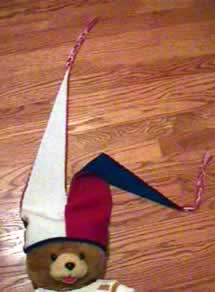
Court Jester Hat
This
page has a pattern generator (aka program) to create a pattern to help
you knit a court jester hat using a knitting machine. You can make your hat in any yarn; just enter the gauge and head size in the program, and you'll get the pattern you need.
Main site, blog (read the latest), ski hat, raspberry beret, crocheted tam, hat collection and Poncho & Cape collection.
You must set your browser to run javascript and to accept cookies to run this program. With some browsers, the address bar should also read "http://www.thedietdiary" at the beginning. If the www's aren't there, stick them in!
Characteristics of the hat:
- Knit sideways using short rows.
- Roll edge hem.
- You may vary the hat size to fit any head.
- You may vary the length of the points from fairly short to as long as you like.
Remember: Like all patterns spit out by my generators, this is
mostly shaping directions.
The purpose of the generators is to let you be
creative, while eliminating the need to do pesky
calculations. You might want to look at jester hats to get ideas for how to modify your hat, or color choices!